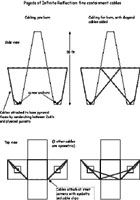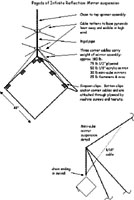
Pagoda of Infinite Reflection
Pagoda Home: Let's make a big mid-week FIRE!
EVENT:
NEW! [Todd]
[Waldemar ! ]
[Others]
Pre-EVENT:
[funding]
[Pre-Compression Raffle]
[how it started]
[who we are]
[early concepts]
[early concepts 2]
[prototype building]
[final design]
[PROJECT PLAN]
[1st burn: Arthur]
[1st burn: Wizzard]
[1st burn: Dr. Wow]
[budget & parts list]
[movies]
[lighting]
[final design 2]
[emails]
[flambe]
[into summer]
[logistics]
[survival]
Team Members:
[Arthur Z]
[Buck]
[Dea]
[Debi]
[Dr. Wow]
[Gerry]
[Jill]
[Marcel]
[Paris]
[Wizzard]
[Movies]
[burner stickers]
Lesson Learned: [Burn Platform]
[Playing Cards]
Emails worth sharing
Attached is a pdf floorplan of the vault showing the mirror layout. Actually seems like a pretty cool geometric pattern.
I can send the original powerpoint to anyone that wants to play with it, add to it, etc.
If anyone sees mirror fabric that looks like the shirt I wore at Flambe, can you pick some up to make the pillows? I would think 4 yards is enough for 4 pillows each 3'x1', but I'm not sewing qualified.
Planning to get a link to my flambe pix up today. Ciao for now!
Arthur
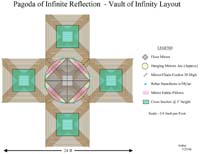
Summary: As shown in cross section below, Playa level has double infinite mirror consisting of a plain mirror on the ground and an infinite mirror on the ceiling, plus interactive hanging deformable mirrors, an interactive hanging feather duster containing fairy lights, and stanchions around the floor mirror containing fairy lights. Second floor contains a smaller double infinite mirror, plus slits in the floor looking directly down at the ground level mirror. Perhaps also telescopes/periscope.
Design of Playa Level: Infinitizer.
1) Infinite Space: Double infinite mirror consisting of one regular mirror on the playa surface filling as much of the central plaza as practical, and one 4x4 infinite mirror hung from the ceiling ~15 above. See plan diagram below, which indicates cross section of inverted pagodas at various heights above ground to suggest walking clearance around floor mirror.
a. Bottom Mirror: Regular mirror on playa surface designed in shape of a stubby cross 6 feet on a side, which can be constructed from one 4x8 sheet of mirror plexi covered with anti-scratch plexi. Investigating cheaper alternatives. See Figure B plan view. Corner niches in cross contain vertical posts with a string of fairy lights strung around the square to keep walkers off the mirror, and which are reflected in the mirror.
b. Top Mirror: Infinite mirror designed using 4x4 full-silver rear mirror, 4x4 half-silver front mirror, one or two 16 fairy light strings with sequencer, and plywood frame. Suspended from floor of 2nd story using 3 turnbuckles or similar leveling feature. Perhaps rotated 45 degrees as shown in plan view.
2) Interactive Light/Cleaning Feature: One or more strings of fairy lights hang from ceiling down to floor above bottom mirror, with a weighted feather duster at the bottom. Visitors swing the duster around to clean the bottom mirror while creating cool infinity effects. Total height change during a swing from center of mirror to edge 3 feet away is approximately 3, within feather duster feather length.
3) Interactive Play Feature: Dozens of small deformable plexi mirrors approx 12x6 hang from beams in the central plaza where they can be aimed anywhere by visitors and bent to create distortions (see demo at next meeting if you havent yet).
4) Givaways: We make a few thousand handheld plexi mirrors with holes to hang on your neck and some kind of artwork/copy about our vision on the back. We can ask everyone to bring them to our burn to reflect the love, or share infinity, or whatever.
5) Additional Action: We can hang a ton of wind chimes around all sides of the inside of the plaza, which will be reflected in the mirrors and create an immersive visual and audio effect. Ideally, stained glass chimes, crystals & prisms to play with sunlight.
Design of 2nd Floor: Infinite Directions.
1) Infinite Fall: Floor of 2nd story pagoda includes slits in its surface just outboard of the 4 square infinite mirror below it. Visitors get down on their hands and knees to peer down through the floor directly at the cross-shaped mirror on the playa surface.
2) Infinite Rise: Double Infinite Mirror consisting of one round 36 diameter regular mirror facing upwards and one ready-made 17 infinite mirror facing down from ceiling (the one used for demos now).
a. The round mirror is raised above the floor on a table made of one _ scale upside down pagoda to provide clearance for visitors looking through the slits in the floor.
b. The ready-made infinite mirror is slid inside the highest pagoda level in which it will fit, and leveled using shims.
3) Interactive Play Feature: More deformable hanging mirrors.
4) Infinite View: Telescopes can be mounted on rails about 4 from the floor of the top pagoda or at the top outboard edges of the inverted pagodas for additional visual interactivity.
5) Alternative: The entire 2nd floor infinite mirror arrangement could be replaced by a giant rotating periscope.
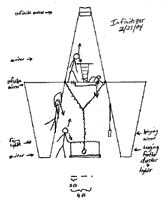
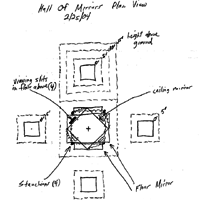
I think I worked out a way to make the large 48" mirror swing freely hanging by a chain from the spinner, yet automatically become nearly hurricane-proof without an axle or U-joint. See attached jpg "Large Mirror Mounting". For the large mirror, we use a "pipe limiter" consisting of a length of pipe at the end of the chain, rigidly attached to the mirror assembly top, and constrained by rings cabled to the towers at both top and bottom of the pipe. The pipe also has some eyelets welded to it, and the mirror ends are secured to the eyelets using cable a la Larry's model last night (112_1240.JPG), with turnbuckles added for adjustability. We size the pipe length and ring diameter to allow a maximum of +/- 6" of travel by the mirror assembly in any horizontal direction, and it can't really go up or down.
This still leaves a big problem. The attached pdf page 2 shows the footprint of the towers at 10 foot altitude, as well as the footprints of all the mirrors without wind - the smaller ones do indeed extend out further than each one's "parent". We're fine without much wind, but if I add 6" of travel to the main mirror, then assume the 12" mirrors swing outwards, they crash into the sides of the towers along most of the tower's width. The interference shown does not even include the chain holding the 12" mirror swinging out, it just assumes pivoting about the top of the 12" mirror. Even without huge winds, centrifugal force from spinning would swing them out.
So, here are a couple options to ponder and improve on:
1) Constrain the 12" mirrors from swinging outwards somehow. I am playing with the idea of using a lever arm above a rotating bearing, as shown in jpg "Small Mirror Mounting". The harder the mirror wants to swing out, the more work must be performed against the lever arm to do it. I'm not thrilled with this method since there are still a couple modes where the mirror can swing up and out (a huge upwards gust), they can still swing in and smash on the large mirror, and we would have cables inside the main mirror.
2 Hang the 12 mirrors on a hinged bar that allows swinging along the direction of rotation but not in/out.
3) Move the 12" mirrors inboard, hanging them from somewhere along the inside edge instead of the corner.
4) Make the 48" mirror a few inches smaller.
5) Install a 6 foot wide, 2 foot high piece of clear plexi on each tower at the height of the potential contact, and hope the plexi to plexi impacts will be tolerated (without the plexi, the 3" mirrors will probably catch between the 2x6's and get torn off, while the mylar will get ripped to shreds).
Ok, I'm out of gas on this one today. Hopefully someone else will have an "aha" now! Or maybe we need to hang a 12" mirror from someone's truck bed, drive 60 miles an hour, and see how far it swings back...
Cheers,
Arthur
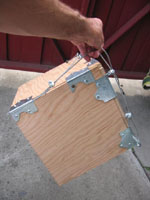
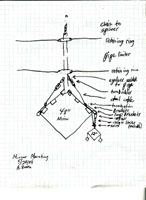
____ Ember | \| | /| | * |
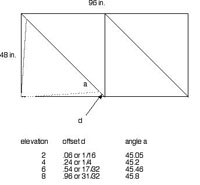
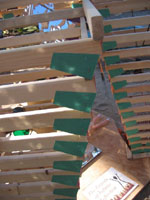
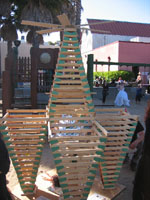
You've seen the model, so you know that the basic construction is fir 2x6's of length 30" to 96", attached by 3/4" oak plywood gussets and screws from one level's face to the next level's end grain. Our test erection of single 15-ft pyramids has shown that they're rigid enough to tip end for end, carry, and stand in any orientation with a few workers climbing on them.
To brace against diagonal loads (which should be small), the cabling establishes diagonals across the base pyramids' big ends. If it's necessary to strengthen 2x6 end grain from splitting or spreading, we will have 1-3/8" screws to run through the 2x6's close to the ends.
The cabling diagram shows the 1/8" galvanized cable that (a) braces against wind loading, and (b) encourages the burning structure to collapse inward rather than outward.
The mirror suspension is designed to hold the overhead mirror assembly securely and to prevent collisions with the pagoda's base pyramids when it's windy. For high winds, we will be prepared to tie down the mirror assembly, and we would of course shoo out participants.
One thing we're still working on is how to disconnect the mirror assembly from the top spinner's rotation if the torque gets too great.
I'll probably be in the office Monday morning, so we could talk further then. -- ~~~~~~~~~~~~~~~~
____ Ember | \| | /| | * |
